Public Transport Key In Waterfront Plan
The redevelopment of Auckland’s waterfront will generate $4.29 billion to the region by 2040, according to a report released by the Minister of Transport, Steven Joyce at a waterfront function at the Voyager Maritime Museum this afternoon.
But the study says to achieve these gains, the redeveloped waterfront must be far more accessible by public transport and walking and cycling, with only 30% of people travelling to the area by car.
“This would improve the transport system in such a way as to support agglomeration by reducing the risk that congestion will impede agglomeration benefits from being realised.”
And the study gives another reason why the CBD rail loop business case makes sense.
It says that, assuming the same 1.4% per year growth in employment experienced over the last nine years, the Auckland CBD is expected to add 13,800 FTEs to 2020. These are net jobs and not a net displacement of jobs from elsewhere in the region. And it adds that this is actually a conservative estimate given the slowdown over the last three years.
The PricewaterhouseCoopers study, commissioned by Sea+City Projects Ltd, the precursor to the Auckland Waterfront Development Agency, projects an additional 40,100 jobs attributable to the redevelopment. It works that out from:
- 13,600 employed in waterfront businesses
- 3,440 employed directly across Auckland as a result of the cruise industry
- 1,800 employed as a result of visitors to Auckland staying another half day to enjoy the atmosphere and activities on the redeveloped waterfront
- 950 employed as a result of major events planned for the waterfront.
In the report, it paints a picture of the Auckland waterfront as it believes it will be in 2040 but says a shift to public transport is needed. It does not mention waterfront trams, the CBD rail link or specific bus improvements (the Link bus is planned to include a route around the area).
The waterfront is expected to be home to more than 3,500 people, with most living south of Pakenham Street, in the bottom half of the Wynyard Quarter.
More than 13,600 people are expected to work on the waterfront in 2040, across a wide range of industries. The largest growth is expected to be in high-productivity business services, with a particular focus on scientific research, surveying, engineering consultant, technical, and computer services. Nevertheless, there will be jobs for people of all skill levels and interests, with a booming Waterfront-linked tourism industry supporting numerous hospitality and retail opportunities. The marine sector will remain a major player on the Waterfront.
The new ASB headquarters to be built around Wynyard Quarter is given as an an example of displacement, where jobs will move from one part of the Region to another because of the attractiveness of the waterfront as a base of operations.
The need for people in the area to walk or use public transport is emphasised in the report.
The study says the number of residents of the Wynyard Quarter (assumed to grow strongly as residential and mixed-use buildings are constructed there) will also need to make far greater use of public transport or active modes (walking and cycling) or will need to work from home, for congestion not to worsen from what it is today.
The table below summarises the reduction in the number of private passenger vehicles that will be able to enter and exit the Wynyard Quarter to keep congestion levels no higher than they are today.
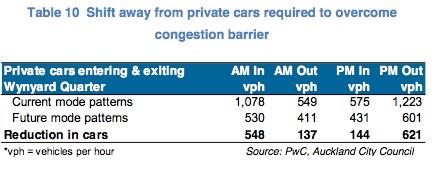 The study estimates that up to 620 fewer vehicles will need to pass in or out of the Wynyard Quarter per hour during peak periods than would do given current modal splits, to ensure that congestion does not increase in the Auckland CBD.
The study estimates that up to 620 fewer vehicles will need to pass in or out of the Wynyard Quarter per hour during peak periods than would do given current modal splits, to ensure that congestion does not increase in the Auckland CBD.
Instead, access to the waterfront is expected to be by a range of modes under this scenario. The ITA estimates that by 2016, almost 3,400 people will arrive on the Waterfront by ferry during the morning peak, with around 6,400 arriving by train at Britomart Station just south of the waterfront area, and a further 9,000 travelling down Hobson and Albert Streets toward the waterfront by bus.
“On the other hand, even if the waterfront does not achieve its mode share targets, it is possible that the amenity benefits of the area may mitigate against potential accessibility constraints. Work undertaken by Williamson et al suggests that some parts of Auckland, such as Takapuna, achieve high employment densities despite poor accessibility.
“If the waterfront can achieve modal shifts toward public transport and active modes greater than the changes set out in the table below, there will be further gains to the Auckland Region in the form of time savings andassociated economic benefits.
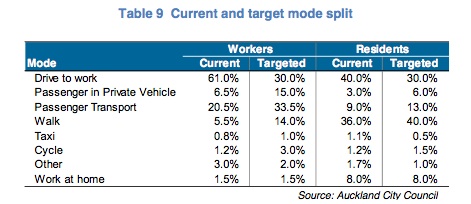 For instance, if more than 64% of waterfront residents travel to work by public transport or active modes, this would likely reduce congestion, resulting in time savings. This is possible if a large proportion of residents of the Wynyard Quarter work within the Auckland CBD.
For instance, if more than 64% of waterfront residents travel to work by public transport or active modes, this would likely reduce congestion, resulting in time savings. This is possible if a large proportion of residents of the Wynyard Quarter work within the Auckland CBD.
“Similarly, the ITA suggests that up to 45% of Wynyard Quarter workers may still travel to work by car in 2016. If this ratio can be reduced due to the higher number of people living and working in the Wynyard Quarter, there may once again be reduced congestion, with time savings as a result.”
The CEO of the Auckland Waterfront Development Agency, John Dalzell, says the whole of Auckland will benefit from the flow-on effects from this major investment by the Auckland Council, Central Government and the private sector.
“This is potentially the most important urban redevelopment project New Zealand has seen,” he said. “It will revitalise our tourism and events industry, attract highly skilled workers and new businesses to the waterfront, strengthen our fishing and maritime industries and attract visitors from all over the world.”
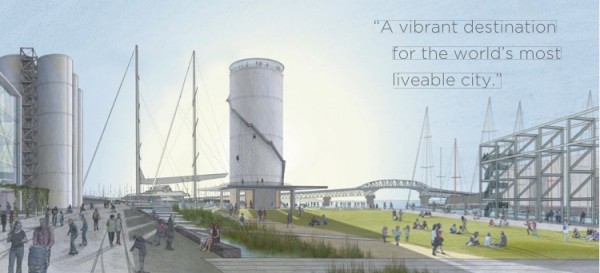 “The Auckland Waterfront, when redeveloped, will be a major driver of Auckland’s economic future. We are developing a social, cultural, heritage and environment showcase on our waterfront. This will not only attract the investment we need, but create a prime destination for people and will be a significant contributor to a more productive Auckland economy. This benefits all New Zealand,” he said. “Our target will be to attract innovative enterprises, with a focus on start-ups and fast growth businesses.”
“The Auckland Waterfront, when redeveloped, will be a major driver of Auckland’s economic future. We are developing a social, cultural, heritage and environment showcase on our waterfront. This will not only attract the investment we need, but create a prime destination for people and will be a significant contributor to a more productive Auckland economy. This benefits all New Zealand,” he said. “Our target will be to attract innovative enterprises, with a focus on start-ups and fast growth businesses.”

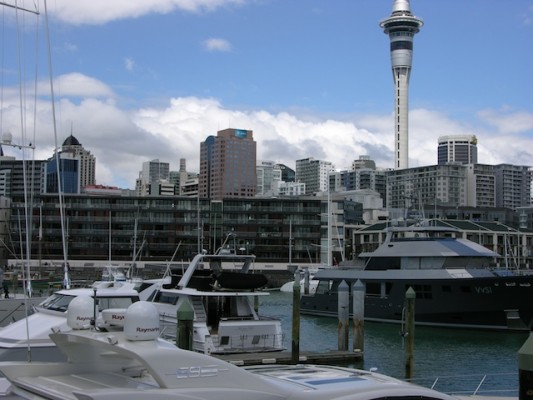
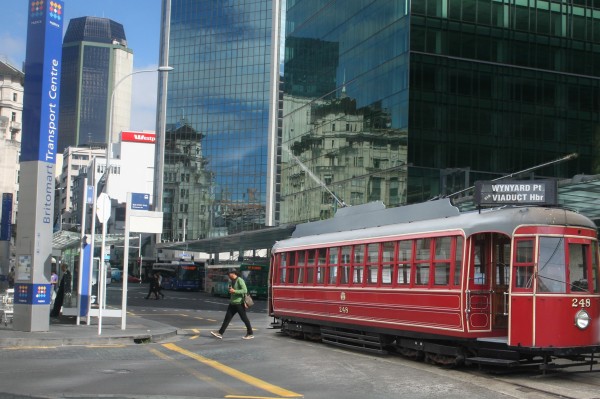










22 Comments
unfortunately the ASB building will be 900m from Britomart. At the far end of walking distance from Britomart.
This may be an appealing walk on a sunny December afternoon, however in the depths of winter many may be put off walking.
The Link bus wont help much as 10min frequency is far too long a wait.
In the long term a Britomart - Wynard Quarter Tram is definitely required.
In the short term some buses could be extended to terminate their runs at Wynard Quarter, which with free transfers could help.
hey dont worry, AWDA are spunking $8million of a loop tram that will go down Dalby,halsey gaunt and jellcoe streets
That should help things nicely
It makes me wonder if they shouldn’t be progressing the first section of the mooted North Shore rail line to service the area, either at the same time or before the CBD tunnel.
Having the station at Halsey St would do wonders to stop people having to drive down there.
I must say I am unimpressed by one very specific element of the targets - targeted cycle shares of 3% and 1.5%? That is laughable, if it wasn’t also something to make one cry.
Why don’t you get a bit more ambitious than achieving half of what already being achieved in Christchurch? You target 40% walking, which frankly is very high, but you can’t imagine that people would choose a bicycle?
I know these mode share targets for the Wynyard Quarter were set many years ago, when some people thought that the last few cyclists in Auckland would go extinct soon, but if you can’t adapt to changing circumstances, what’s the use of all these new reports?
A dreams are free design… A tram starting at Britomart, to Jellicoe, Beaumont, Under the Victoria Park Flyover, Napier Lane, Hepburn, Williamson, Tuarangi, Great North, St Lukes Road, Morningside Drive to Morningside station. Dreams are free!
Surely the PT access issue is a no-brainer. They are already building a 1.5km tram loop, and it would only take an 850m branch for trams to reach Britomart and the Ferry terminal, or 1.2km if they go the long way to avoid crossing the harbour.
Why the hell is Steven Joyce launching this report? it was initiated by a CCO not the government so he shouldn’t be getting involved.
Also its interested that he supports urban development on the waterfront creating jobs but not urban development elsewhere in the CBD that would be brought about by the CBD tunnel.
@Matt L Since they couldn`t get their man in the mayors position who would have done what he was told, Steven Joyce has taken it upon himself to keep an eye on everything Auckland is doing including this, the spatial plan and I guess anything else where his government has self interests at stake and where policy decisions in the other direction by the local government has the possibility to hinder in the future things he and his ilk have in mind.
As far as he and National are concerned, this local govt and authorities to redevelop Auckland are not to be trusted!
@Geoff, that was the original plan (tram link to Britomart) however the Banks administration cancelled the proposed viaduct harbour bridge as a cost cutting measure and replaced it with a cheaper ‘temporary’ footbridge to be slapped up in time for the rugby world cup, one that cannot handle the weight of anything but pedestrians.
The idea is still to extend the tram if/when the permanent bridge is built (possibly never, temporary structures have a habit of becoming permanent). The roundabout ‘landside’ route is a bit circuitous with lots of right angle turns, and pretty inferior to the bridge route… so we can really only hope that a replacement bridge is built sometime in the nearish future. Really it needs to be built now so that the high quality public transport is in place when tenants start moving in… not five or six years after everyone has gotten used to driving there.
I worry that as the ASB building is being built now, with lots of industrial land around, that they will just have lots of car-parks in the area, and more people will drive than if the building was a few 100m closer to Britomart/PT links.
Its all very well having these targets but they have to be matched by investment in quality PT and good pedestrian linkages to the wider CBD.
I work for ASB and the new building is about as far from Britomart as the old one and a flatter route, so I don’t see any problem. Most of the people I work with catch PT in anyway. As for me, I look forward to catching the train. Right now I bus in order to get to midtown, but I generally catch the train if I’m going Downtown. I believe the parking provision is the same as the current building, however as the new building is ASB exclusive there will be a total decrease in carparks from the current building.
I somehow feel that trams just don’t match Auckland at all…
Kel - give me a reason? Because there’s way too many cars already? Have you lived (or spent at least some weeks or months) in a city with trams? They are such highly pleasant and efficient ways of travelling.
Trams fit pretty much any city wonderfully. The discussion is more whether old heritage trams with battery power in a somewhat forlorn (at least for the coming decade at least) corner of the waterfront will do anything worth calling “transport”.
karl, what’s wrong with that mode share target for cycling? From 1.2% share to 3% share with no growth in overall numbers would be more than 100% growth in the number of cyclists in the space of six years. But since it’s accompanied by a projected increase in overall numbers it means growth in the number of cyclists of over 200% of current. That’s huge growth.
Kel, Auckland was built around trams. Prior to WWII they were pretty much the only way to get around, even the railways were limited at that point.
The inner parts of Auckland are perfect for trams because these areas were designed around trams being the mode of transport for most of the people who lived there!
Matt, the fact is that at a low level, growth is easy. If someone makes 0.5% profit one year, and then makes a 4% profit the next year, he can claim to have increased his profit by a factor of eight! 800% growth on earnings! Even though 4% profit is still less than what he would have gotten if he had put his money in the bank.
Same here - whether a target is ambitious or not is measured by comparative environments that have already achieved something. The current NZ cycle to work share is 2.5% - so these guys are barely aiming above our current anemic levels. Some cities in NZ have already achieved 5-7%, and some parts of Europe at the top of the scale achieve 20% or more.
Lastly, it seems that those tables are long-term forecast, potentially up to the 2040 mentioned in the very first para. So within 30 years, all they assume as possible is to get a few hundred more people on bikes? That’s not ambitious, that’s thinking “Oh, we don’t really believe in bikes, but they sound green, let’s add a few of them into the mix”.
Don’t get me started on the recreational cycle split, btw. 1.5%??? While having a 40% walk split at the same time? It boggles me that they don’t see how the two improvements go hand in hand. I don’t think it would even be POSSIBLE to get a 40% walking split without getting a 5%-10% cycle split at the same time, as a direct result of the improvements you’d have to make to get the walking environment that good in the first place.
Max, we’ve established that Auckland is mostly hostile to cyclists. Around the CBD that’s probably not going to change terribly much, mostly because there’s not a lot of space available once you account for the necessity of at least one traffic lane in each direction and the likelihood of a bus lane in each direction on most of the major roads.
We don’t know what assumptions were made about making changes to the pro-cycling environment, if any, so they may have just calculated growth rates and projected them forward rather than specifically aiming to grow the cyclist mode share.
I got the impression that those figures were to 2016, from the text around them. If it’s actually to 2040 then yes, that is woeful.
Matt, I don’t want you to take this personally.
But that’s defeatist talk.
NEW YORK managed to make space for bicycles. If they can do it, so can we.
Existing example:
http://commons.wikimedia.org/wiki/File:WTM3_Gnarly_0030.jpg
Planned example:
http://transportblog.co.nz/2010/01/30/new-york-bus-rapid-transit-brt/
The above are perfect examples what should be done on Nelson Street and Hobson Street, and probably on places like Fanshawe or Quay.
Further, shared space and other concepts can humanise and slow down our traffic, to a degree where fancy separated routes are not necessary anymore in those areas.
Why should our CBD stay hostile? I don’t believe in this “Mike Hoskins talk” - that we have backed ourselves into a corner with no way out, so we should stop trying. I want kids and old grannies to be able to go downtown on their bike. That is what I fight for.
Max, if you haven’t noticed there are many more entry points to the CBD than Hobson/Nelson and Fanshawe. Quay is pushing it to have both bus lanes and that kind of cycle lane, and if we want to take cycling seriously then sharing with buses ain’t a goer.
I’ll say it again, most streets into and around the CBD do not have the width for useful pedestrian space, bus lanes, traffic lanes, and cycle lanes.
If we’re happy with the shared bus/cycle lanes, which I think most people believe to be a poor-man’s compromise, then it’s possible. If we want real cycle lanes, though, then we’re starting to run out of space to fit all these things in without widening the transport corridor.
Matt, the examples I showed you are separated bike lanes, not shared with buses. And no, I do not believe shared bus lanes are a good compromise. They only work for confident cyclists, and those aren’t the target market - they already cycle.
Not quite sure what your comment about “many more entry points” is supposed to be about. It seems to contradict your earlier comments that leaned in a “we can’t do it, no space” direction. Or are you saying I should have listed even more streets where I want cycle facilities? I sure could, but I don’t see the point right here. I was just listing a few which would be useful. But while we are at it, add a Beach Road -Fanshaw Road cross-town separated link to the wish list. Wide streets, but horrible cycling environment for newbies.
“I’ll say it again, most streets into and around the CBD do not have the width for useful pedestrian space, bus lanes, traffic lanes, and cycle lanes.”
And I’ll say it this way - not every street NEEDS all those facilities. Not every single road in the city needs bus lanes. I even dispute the point that every road into the city needs GENERAL traffic lanes, full stop. Simply keeping the status quo for cars and then fiddling around the edges of that will not change this city.
Plus, the narrower streets can go shared space or become more traffic-calmed in general. What is needed is simply a few primary cycling routes in and out, and a safe way to disperse within the CBD.
Matt and Max your points also all show the desperate need for the expansion of rail: the CBD is horribly clogged with buses, these, especially the old tech diesel monsters are vile and dangerous for both pedestrians and cyclists. In other words; humans. Sorry Mr Bus from Sydney but rail IS the panacea, because it is ‘offline’ from all the other important users of our streetscape. Time to dig.